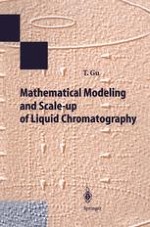1995 | OriginalPaper | Buchkapitel
Modeling of Multicomponent Gradient Elution
verfasst von : Prof. Dr. Tingyue Gu
Erschienen in: Mathematical Modeling and Scale-up of Liquid Chromatography
Verlag: Springer Berlin Heidelberg
Enthalten in: Professional Book Archive
Aktivieren Sie unsere intelligente Suche, um passende Fachinhalte oder Patente zu finden.
Wählen Sie Textabschnitte aus um mit Künstlicher Intelligenz passenden Patente zu finden. powered by
Markieren Sie Textabschnitte, um KI-gestützt weitere passende Inhalte zu finden. powered by
Gradient elution chromatography is a very important method in chromatographic separations, especially for proteins, because they have a wide range of retentivity. In gradient elution, a modulator is used in the mobile phase to adjust eluent strength. The modulator can be acetonitrile in reversed phase chromatography, or ammonium sulfate in hydrophobic interaction chromatography, or sodium chloride in ion-exchange chromatography. In ion-exchange chromatography, a pH gradient may also be used. The modulator concentration in the mobile phase is increased (or decreased as in hydrophobic interaction chromatography) continuously with time. This change in the strength of modulator allows gradient elution to separate components with widely different retentivities. In preparative- or large-scale operations, gradient elution can concentrate a sample while achieving a purification at the same time. In isocratic elution, a sample is always diluted to a certain degree. Because of this, gradient elution is often desired when handling large volumes of sample.
